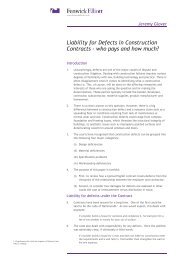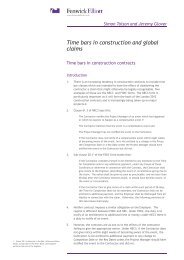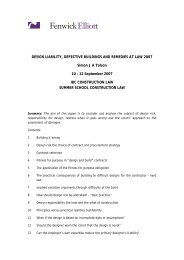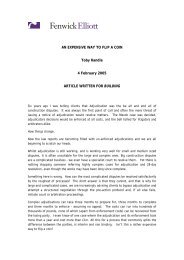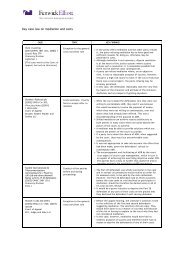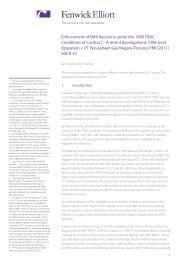Standard forms: JCT 2005, NEC3 and the Virtual ... - Fenwick Elliott
Standard forms: JCT 2005, NEC3 and the Virtual ... - Fenwick Elliott
Standard forms: JCT 2005, NEC3 and the Virtual ... - Fenwick Elliott
Create successful ePaper yourself
Turn your PDF publications into a flip-book with our unique Google optimized e-Paper software.
<strong>St<strong>and</strong>ard</strong> <strong>forms</strong>: <strong>JCT</strong> <strong>2005</strong>, <strong>NEC3</strong> <strong>and</strong> <strong>the</strong> <strong>Virtual</strong> Contract<br />
www.fenwickelliott.co.uk<br />
Construction projects take time on site to complete. It is, <strong>the</strong>refore not unusual for projects<br />
to be delayed because of a variety of influences, many of which are external to <strong>the</strong> parties,<br />
but also as a result of changes to <strong>the</strong> scope of work to occur. Some have argued that<br />
changes to <strong>the</strong> work can be avoided by simply completing <strong>the</strong> design before issuing <strong>the</strong><br />
tender. A frequent practice within <strong>the</strong> construction industry, at least in <strong>the</strong> UK, appears to<br />
be issuing an incomplete design at tender stage which is <strong>the</strong>n supplemented by changes<br />
to <strong>the</strong> design <strong>and</strong> fur<strong>the</strong>r variations as <strong>the</strong> work proceeds.<br />
This in part might be due to a particular employer’s inability to precisely define his or her<br />
brief, <strong>and</strong> also because of <strong>the</strong> employer’s perceived urgency to commence work of site<br />
as early as possible, in perhaps <strong>the</strong> erroneous belief that <strong>the</strong> project will be completed at<br />
<strong>the</strong> earliest possible time. Could it be <strong>the</strong> case that a later start on site, but with a totally<br />
completed design might in fact lead to a project that, with minimal extensions of time, is<br />
completed earlier <strong>and</strong> with greater cost certainty?<br />
It has been <strong>the</strong> drive towards greater certainty as to outturn cost <strong>and</strong> a need to meet a<br />
planned completion date that more novel approaches to procurement have developed.<br />
The result, of course, is that st<strong>and</strong>ard <strong>forms</strong> have developed in order to meet <strong>the</strong>se<br />
procurement pathways. Initially, <strong>JCT</strong> produced prime cost contracts for cost plus work, as<br />
well as management contracting <strong>forms</strong> <strong>and</strong> st<strong>and</strong>ard <strong>forms</strong> for works package contractors.<br />
The ICE has stuck with its traditional approach, albeit with <strong>the</strong> development of <strong>the</strong> design<br />
<strong>and</strong> build version, but o<strong>the</strong>r new st<strong>and</strong>ard form providers have entered <strong>the</strong> arena.<br />
The NEC (now <strong>the</strong> Engineering <strong>and</strong> Construction Contract, Third Edition) has been<br />
produced by a private publisher, Thomas Telford (owned by <strong>the</strong> ICE) in order to provide<br />
a suite of contracts for a variety of different procurement pathways. The NEC approach<br />
must be <strong>the</strong> most novel mainly because <strong>the</strong> NEC has adopted a less is best approach to<br />
<strong>the</strong> drafting, resulting in very short clauses.<br />
The NEC Form comprises a front end “black book” which includes all of <strong>the</strong> core clauses<br />
that might be used to produce a contract to meet <strong>the</strong> procurement pathway adopted by<br />
<strong>the</strong> employer. These fur<strong>the</strong>r breakdown into <strong>the</strong> rainbow coloured suite of contractual<br />
variations which comprise:<br />
(a) priced contract with activity schedule “purple book”<br />
(b) priced contract with bill of quantities “blue book”<br />
(c) target contract with activity schedule “yellow book”<br />
(d) target contract with bill of quantities “red book”<br />
(e) costs reimbursable contract “light green book”<br />
(f ) management contract “green book”<br />
In addition, <strong>the</strong>re is <strong>the</strong> engineering <strong>and</strong> construction sub-contract, <strong>the</strong> guidance notes<br />
<strong>and</strong> flow charts which identify <strong>the</strong> procedures that should be followed when using <strong>the</strong><br />
NEC. The flowcharts are expressed not to be a part of any contract, but <strong>the</strong>y clearly depict<br />
how <strong>the</strong> authors consider how <strong>the</strong> NEC contract is to be used in practice.<br />
Despite <strong>the</strong> ongoing development of apparently new procurement pathways <strong>and</strong> <strong>the</strong><br />
proliferation of st<strong>and</strong>ards <strong>forms</strong>, <strong>the</strong> selection of a particular st<strong>and</strong>ard form for any particular<br />
project is often based on familiarity. In o<strong>the</strong>r words, <strong>the</strong> construction professional, perhaps<br />
3




